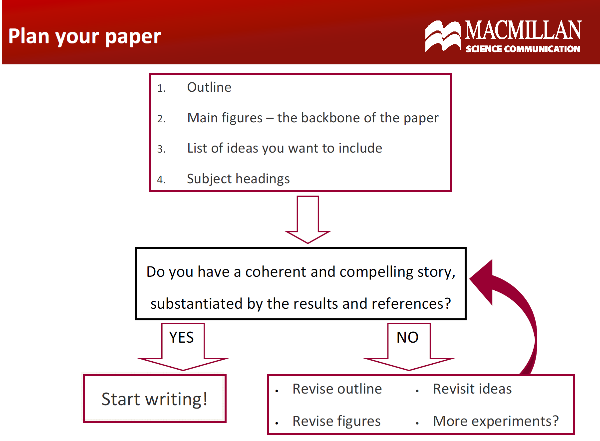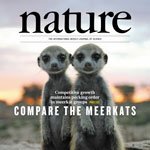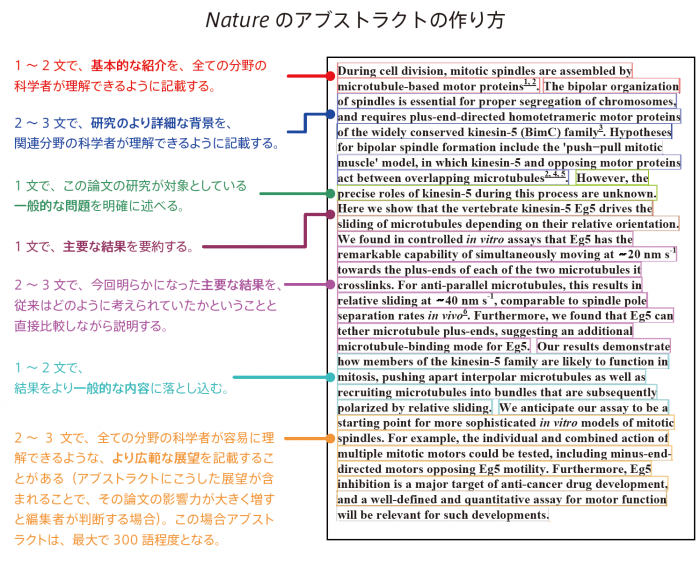論文が掲載された雑誌のインパクトファクターの高さと、その論文自体の価値の高さは必ずしも一致しません。そのため、雑誌のインパクトファクターにとらわれずに論文の内容そのものを評価すべきだという議論がよくなされます。しかしながら、分野外の論文の価値を評価するのは非常に難しいため、雑誌のネームバリューで論文業績が評価されるということは避けられません。
そんなこともあって、いまどき、ネイチャー(Nature)、サイエンス(Science)、セル(Cell)(生命科学分野の場合)、あるいはそれらの姉妹紙などにファーストオーサーの論文を出していないと、アカデミックな世界でジョブマーケットに出て行くことが難しいという現実があります。テニュアトラック制度に乗っているPI(Principal Investigator)も、自分のラボからこのようなトップジャーナルに論文を出さないとテニュア獲得の可能性が下がるでしょう。
それでは一体、Natureなどのハイプロファイルジャーナル(High-profile journals)に論文を出すための秘訣や戦略のようなものは存在するのでしょうか?
日本のラボで仕事をする日本人ポスドクよりも、海外のラボに留学した日本人ポスドクの方が一流誌に論文が出やすいということはよく言われます。なぜそうなるのかといえば、海外のトップラボのボスは良い論文を書く方法論を身につけているからです。そのため、せっかく同じような実験データを得ていながら、かたやネイチャー、かたやインパクトファクターの低い雑誌という結果にもなります。
Natureに論文を出すための方法論はどこでどう身につければよいのでしょうか?もちろん、良いボスがいる一流のラボで仕事をして直接学ぶのがベストの方法ですが、実は、良い論文を書くためのワークショップをNature自身が多数開催しています。また、インターネット上で、それらの内容が公開されています。
 (参照:ネイチャーライティングワークショップ
(参照:ネイチャーライティングワークショップ http://www.jbr-pub.org/UploadFile/Nature%20Writing%20Workshop.pdf 30ページ)
良い論文というのは、我々の自然に対する理解を深めるような研究報告です。つまりConceptual Advanceがなければいけません。Conceptual Advanceがどのようなもので、それが論文掲載の決定にどう関わってくるかに関しては、
Novelty and conceptual advance
• Anything that has not been published before is novel, but not all
novel findings are considered interesting, or of sufficient conceptual
advance, for a journal
• Different journals use different criteria to gauge the level of
conceptual advance and readers’ potential interest
Common types of conceptual advance
• Unexpected phenomenon
• Never before seen
• Mechanistic insight
• Technical breakthrough
• Resource value
(参照:ネイチャーライティングワークショップ http://www.jbr-pub.org/UploadFile/Nature%20Writing%20Workshop.pdf 19ページ)
と説明されています。
ネイチャーに論文を出す方法について、ネイチャーのエディターが解説した動画。
How to Publish in Nature – Leslie Sage (SETI Talks)
ネイチャーが論文をアクセプトするかどうかは一体誰が決めているのでしょうか?それは、レビューアー(差読者)ではなくネイチャーの編集者であると明言されています。
The judgement about which papers will interest a broad readership is made by Nature‘s editors, not its referees. One reason is because each referee sees only a tiny fraction of the papers submitted and is deeply knowledgeable about one field, whereas the editors, who see all the papers submitted, can have a broader perspective and a wider context from which to view the paper. (http://www.nature.com/nature/authors/get_published/)
Nature, Nature Physics and Nature Communicationsなどの編集者も務めたDan Csontos博士が、ネイチャーに論文を出す秘訣を解説。
How to get published in top-ranked journals
Dr Dan Csontos. He is a science writer, editor and publishing consultant at Elevate Scientific, based in Lund, Sweden. Before founding Elevate he was a science editor with the international journals Nature, Nature Physics and Nature Communications, and a science editor and project manager with Macmillan Science Communications in London.
ネイチャー論文の要旨の書き方
ABSTRACTの書き方だけでなく、ネイチャーに投稿する際の要点が、https://www.natureasia.com/pdf/ja-jp/nature/authors/gta-2017.pdfにまとめられています。
参考
- Foundation Scientific Writing and Publishing Workshop:Trainers: Dr.Myles Axton (Nature Genetics Chief Editor), Dr.Wayne Peng (Formerly an Associate Editor, Nature)(ネイチャーライティングワークショップ 284 page PDF)
- How to get published in Nature (and its sister journals) Ed Gerstner,Executive Editor. Nature Communications. March 2014 (PDF link)
- How to get published in Nature Publishing Group Journals. By Nick Campbell.Assistant Publisher and Executive Editor NPG Nature Asia-Pacific (PDFリンク)
- Publishing your research in Nature journals, Myles Axton, Chief Editor, Nature Genetics. Taiwan, November 2014. (37 pages PDFリンク)
- How to get published in Nature Communications. Nicky Dean, Associate Editor Nature Communications. (PDF link)
- Scientific writing 101 (Nature Structural & Molecular Biology, Feb 2010;17(29):139 EDITORIAL)(PDF link)
- Getting published in Nature: the editorial process (nature.com)
- サイエンス(Science)に論文を出す方法
- 圧倒的に生産性の高い人(サイエンティスト)の研究スタイル (ニューロサイエンスとマーケティングの間 – Being between Neuroscience and Marketing 2008-10-18) :1. まずイシューありき 2. 仮説ドリブン 3. アウトプットドリブン 4. メッセージドリブン
同じカテゴリーの記事一覧
- 科研費の採否はここで決まる!研究計画調書(申請書)の書き方~項目別実践的攻略ポイント~
- 蓮舫氏「2位じゃダメなんですか?」発言の真相:切り取られて作られた報道
- 科研費が採択されない人の特徴
- 論文を書き始めることができないんですけど?
- 科学論文で使える英語表現、語句、英単語
- 英語論文の書き方:文と文とをつなげる
- 利根川進博士のぶっちゃけ話:研究者として成功できた理由および成功戦略
- 東北大学の女性限定教授公募の波紋「教授って合コンサークルか何かなのか?」
- 数量化1類、数量化2類、数量化3類、林知己夫の数量化理論
- 大学教員を目指す公募戦士の戦い方、デキ公募という難敵の回避方法など
- 研究の行き詰まりを打開する18のアイデア
- 【科学英作文】useを使うかutilizeを使うか?使い分けの考え方
- 生命医科学研究領域の論文出版数で測った日本の大学の研究力ランキング
- 科研費に採択されるための教科書と副読本、厳選5冊
- ラボは何時間労働?ボスからの手紙
- 研究者にとっての論文十ヶ条
- この2つを意識するだけで作文能力が劇的に上がる:cohesion(連結)とcoherence(首尾一貫)
- 科研費が不採択だったら、開示された審査結果を分析して改善点を探そう
- ただいま「所属研究機関処理中」2020年度(令和2年度)4月1日午前10時00分、科研費交付内定が通知される
- 大学における第3の職種URAとは?科研費獲得増の効果は?
- 臨床医のための 臨床研究テーマの見つけ方
- 科研費は基盤Aか、手堅くBか、審査区分は?
- 科学研究費助成事業公募要領等説明会(文部科学省・日本学術振興会主催)が開催される
- 「3た」論法とは
- まだ紙の実験ノート使って研究してるの?【電子実験ノートの浸透】
- 実験ノートの書き方
- 実験におけるポジコン、ネガコンの重要性【研究の基本的な作法】
- 平成22年度(2010年度)科学研究費補助金 新学術領域研究(研究提案型)に係る事後評価報告書(最終報告書)
- 平成23年度(2011年度)科学研究費補助金 新学術領域研究(研究提案型)に係る事後評価報告書(最終報告書)
- 平成25年度(2013年度)科学研究費補助金 新学術領域研究(研究提案型)に係る事後評価報告書(最終報告書)
- 平成24年度(2012年度)科学研究費補助金 新学術領域研究(研究提案型)に係る事後評価報告書(最終報告書)
- 【変わる科研費】新学術領域研究を見直しへ~制度の主な変更点~
- レジデントノート2月号(2019年)の特集「学会発表にトライ!」
- 効果的な科学プレゼンテーションをつくりあげる方法
- 英文校正業者の選び方と英文校正の利用の仕方
- 2019年4月1日科研費の採択が通知される
- 医学系の学術雑誌インパクトファクター 2018ランキング
- ImageJインストール方法と使用事例
- 今まで誰も教えてくれなかった「人前で話す極意」鴨頭嘉人 (かもがしら よしひと)の話し方教室
- 成功するジョブトーク(面接セミナー)のやり方
- アカデミアでの推薦状の書き方と文例(英・日)
- 生命科学研究者にお勧めの新刊・既刊
- 研究者のための科学英語プレゼントレーニング大学院講義
- 平成31年度科研費採択を目指し計画書を書く(ง •̀_•́)ง‼
- Research Statementの書き方
- 論文執筆時の注意点:曖昧さの排除
- 論文数世界ランキングで日本は6位に後退
- 大きな差を生む小さな習慣:実験ノートの効果的な書き方
- 手段はusingかby usingかbyかwithか?
- あなたが論文を書けない理由がわかる40の質問

